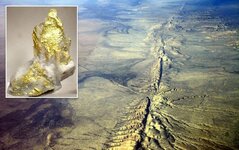Stand Watie
Jr. Member
Interesting article from a science site.
Earthquakes Deposit Gold in Fault Zones

Gold deposits may be created in a flash—literally. Along fault zones deep within Earth's crust, small cavities filled with fluids rich in dissolved substances such as gold and silicate minerals can expand suddenly to as much as 130,000 times their former size during a major earthquake, a new analysis suggests. In such circumstances, pressure drops accordingly, driving a process the scientists call flash evaporation. And when the pressure in the cavity suddenly drops, so does the solubility of minerals in the water there. Along with substantial quantities of quartz, large earthquakes could deposit as much as 0.1 milligrams of gold along each square meter of a fault zone's surface in just a fraction of a second (gold-flecked chunk of quartz from the Red Lake Mine of Ontario, inset). Because mineral-rich waters continually infiltrate cavities along the fault, ore deposits accumulate with each passing quake. Typical rates of seismicity along a fault, such as the San Andreas fault zone shown in the main image, could generate a 100-metric-ton deposit of gold in less than 100,000 years, the team reports online today in Nature Geoscience. More than 80% of the world's gold deposits may have been formed via flash evaporation along fault zones, the researchers estimate. The new model may even lead to a new style of mineral exploration, they say: Just look for the ancient fault zones.
Earthquakes Deposit Gold in Fault Zones

Gold deposits may be created in a flash—literally. Along fault zones deep within Earth's crust, small cavities filled with fluids rich in dissolved substances such as gold and silicate minerals can expand suddenly to as much as 130,000 times their former size during a major earthquake, a new analysis suggests. In such circumstances, pressure drops accordingly, driving a process the scientists call flash evaporation. And when the pressure in the cavity suddenly drops, so does the solubility of minerals in the water there. Along with substantial quantities of quartz, large earthquakes could deposit as much as 0.1 milligrams of gold along each square meter of a fault zone's surface in just a fraction of a second (gold-flecked chunk of quartz from the Red Lake Mine of Ontario, inset). Because mineral-rich waters continually infiltrate cavities along the fault, ore deposits accumulate with each passing quake. Typical rates of seismicity along a fault, such as the San Andreas fault zone shown in the main image, could generate a 100-metric-ton deposit of gold in less than 100,000 years, the team reports online today in Nature Geoscience. More than 80% of the world's gold deposits may have been formed via flash evaporation along fault zones, the researchers estimate. The new model may even lead to a new style of mineral exploration, they say: Just look for the ancient fault zones.
Upvote
0



